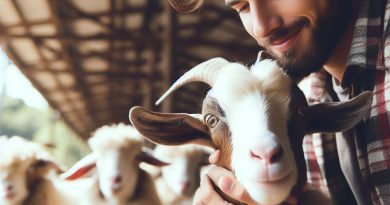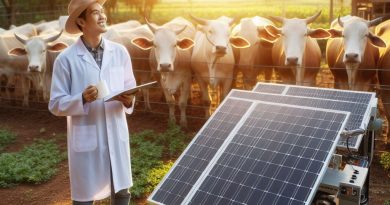Rotational Grazing: A Complete Guide
Last Updated on January 25, 2024
Introduction
Rotational grazing is an effective method of managing livestock by moving them from one pasture to another at regular intervals.
This practice aims to maximize forage utilization and promote healthy plant growth while mitigating negative environmental impacts.
Implementing rotational grazing offers numerous benefits for both farmers and the environment.
Definition and overview of rotational grazing
Rotational grazing involves dividing a pasture into smaller paddocks, creating a rotational system where livestock are moved from one paddock to another.
The size and duration of each rotation may vary based on factors such as forage availability, livestock needs, and environmental conditions.
This method allows forage plants to recover and grow while ensuring livestock have access to fresh and nutritious grazing areas.
Importance and benefits of implementing rotational grazing
Implementing rotational grazing provides multiple benefits.
Firstly, it improves pasture quality and plant growth by allowing sufficient rest and recovery time for grazing areas.
This helps maintain a diverse and nutritious plant community, promoting better animal health and productivity.
Furthermore, rotational grazing helps prevent overgrazing and soil erosion, as livestock are continuously moved to fresh paddocks.
The grazing pressure is evenly distributed, allowing for even utilization of forage and minimizing damage to plants and soil structure.
This, in turn, supports soil health and reduces the risk of runoff and nutrient loss.
Additionally, rotational grazing can improve pasture resilience against weeds, as healthier and denser plant communities are more competitive.
It also enhances biodiversity by creating diverse habitats for various plant species, insects, and birds.
Therefore, rotational grazing is an effective management strategy that provides numerous benefits for farmers and the environment.
By implementing this practice, farmers can optimize forage utilization, enhance livestock health and productivity, and maintain a sustainable and resilient grazing system.
Understanding the Basics of Rotational Grazing
What is rotational grazing?
Rotational grazing is a strategic method of managing livestock where they are moved through different pastures.
Difference between rotational grazing and continuous grazing
In rotational grazing, livestock are moved from one pasture to another, while in continuous grazing, they stay in one pasture.
How rotational grazing works
- Divide the grazing area into multiple paddocks or pastures.
- Livestock are moved to one pasture and allowed to graze for a specific period.
- After grazing, they are moved to the next pasture to allow the previous one to recover.
Key principles and goals of rotational grazing
- Improved forage utilization: Rotational grazing helps animals utilize available forage more efficiently.
- Enhanced pasture health: By allowing pastures to rest and recover, rotational grazing improves their overall health.
- Weed and pest control: Rotating livestock through pastures helps control weeds and disrupt pest life cycles.
- Soil health and nutrient cycling: Rotational grazing promotes better soil health and nutrients cycling by minimizing overgrazing.
- Water quality and conservation: Controlled grazing reduces soil erosion and nutrient runoff, improving water quality.
- Animal health and performance: Proper forage management through rotational grazing leads to healthier and more productive animals.
- Increased carrying capacity: By optimizing forage utilization, rotational grazing can support more livestock on the same land.
- Biodiversity and wildlife habitat: Rotational grazing promotes diverse plant species and creates habitats for wildlife.
- Economic benefits: Improved forage quality, reduced input costs, and increased livestock productivity contribute to financial gains.
List of benefits of rotational grazing
- Increased pasture productivity
- Enhanced soil fertility
- Reduced need for supplemental feed
- Reduced environmental impact
- Decreased reliance on chemicals
- Improved carbon sequestration
- Increased farm profitability
- Long-term sustainability
Common rotational grazing systems
- Time-controlled grazing
- High-intensity-low-frequency grazing
- Ultra-high-density grazing
- Strip grazing
- Mob grazing
- Managed intensive rotational grazing
Considerations for implementing rotational grazing
- Adequate fencing and water sources in each pasture
- Regular monitoring of forage growth and pasture condition
- Proper timing and duration of grazing periods
- Stocking rate based on carrying capacity and forage availability
- Maintenance and improvement of fences, water systems, and infrastructure
Rotational grazing is a powerful tool that can improve pasture health, increase livestock productivity, and enhance overall farm sustainability.
By understanding its basics and implementing key principles, farmers can benefit from improved forage utilization, soil health, water quality, and economic viability.
Read: 5 Key Soil Health Tips for Better Pastures
Setting Up a Rotational Grazing System
In order to establish a successful rotational grazing system, several important factors need to be considered:
Evaluating the land and its suitability for rotational grazing
- Assess the soil type, fertility, and drainage to ensure it can support rotational grazing.
- Identify any potential obstacles or hazards that may affect the grazing system.
- Consider the topography of the land and how it might impact the movement of livestock.
Fencing and infrastructure requirements
- Install sturdy and secure fencing to separate the land into different paddocks for rotational grazing.
- Choose fencing materials that are appropriate for your livestock and the specific needs of your rotational grazing system.
- Consider the installation of water troughs, shade structures, and other infrastructure to support the grazing system.
Determining the number of paddocks and their size
- Divide the available land into an appropriate number of paddocks based on the size of your livestock herd.
- Consider the carrying capacity of each paddock and ensure it can provide sufficient forage for the livestock.
- Keep in mind that the size of the paddocks may need to be adjusted over time based on the condition of the land and the grazing patterns of the livestock.
Water and forage considerations
- Ensure that each paddock has access to a reliable source of clean water.
- Consider the availability of forage in each paddock and make any necessary adjustments to ensure adequate grazing.
- Implement strategies such as rotational mowing and overseeding to maintain and improve forage quality.
Creating an efficient grazing plan
- Develop a comprehensive grazing plan that outlines the rotation schedule for your livestock.
- Consider factors such as forage regrowth time, rest periods for paddocks, and the nutritional needs of the animals.
- Monitor the condition of the land and the livestock regularly to make adjustments to the grazing plan as needed.
By carefully evaluating the land, implementing appropriate fencing and infrastructure, determining the number and size of paddocks, considering water and forage availability, and creating an efficient grazing plan, you can successfully establish a rotational grazing system.
This management strategy not only improves soil health and forage quality but also promotes the overall well-being of your livestock.
Read: Beef Cattle Grazing: Best Practices

Rotational Grazing Management
Rotational grazing techniques and methods
- Strip grazing – dividing pasture into narrow strips and allowing livestock to graze one strip at a time.
- Paddock subdivision – splitting a larger pasture into smaller paddocks to control grazing patterns.
- Cell or management-intensive grazing – rotating livestock frequently between smaller cells to maximize forage utilization.
Frequency and timing of rotational moves
- Rotate livestock to a new grazing area when forage in the current paddock reaches a specified residual height.
- Moving livestock too early may result in underutilized forage while moving too late may cause overgrazing.
Monitoring and evaluating pasture condition
- Regularly assess the height and density of forage to determine if it meets the desired nutritional needs of livestock.
- Use tools such as the grazing stick or pasture measurement techniques to estimate forage availability and utilization.
Adjusting stocking rates and paddock utilization
- Adjust stocking rates based on forage availability and growth rates to prevent overgrazing or underutilization.
- Monitor livestock performance and make necessary adjustments to prevent overfeeding or underfeeding.
Implementing rest and recovery periods
- Allow pasture areas to rest between grazing periods to promote plant regrowth and improve overall pasture health.
- Rest periods can vary depending on the forage species and environmental conditions, but typically range from weeks to months.
By following these rotational grazing management practices, farmers can effectively utilize pasture resources, optimize forage productivity, and maintain healthy livestock.
Read: Quail Nutrition: What to Feed for Best Results
Benefits of Rotational Grazing
Rotational grazing has numerous benefits that improve the overall health and productivity of livestock operations.
By implementing this grazing system, farmers and ranchers can experience significant improvements in forage quality, quantity, carrying capacity, animal performance, soil health, and weed control.
Additionally, rotational grazing practices contribute to environmental sustainability and better land management practices.
Improved forage quality and quantity
One of the key advantages of rotational grazing is its ability to improve forage quality and quantity.
By rotating livestock between paddocks, grazing pressure is evenly distributed, allowing for better utilization of forage plants.
This results in healthier and more nutritious forage, which directly benefits the animals’ diet and overall performance.
Increased carrying capacity and animal performance
Furthermore, rotational grazing increases the carrying capacity of the land and improves animal performance.
By moving animals to different grazing areas, farmers can ensure that each paddock has enough time to recover before being grazed again.
This rotation prevents overgrazing, allows for proper plant regrowth, and maximizes the land’s potential to support more animals.
Enhanced soil health and nutrient cycling
Another significant benefit of rotational grazing is its positive impact on soil health and nutrient cycling.
As animals graze and deposit manure in one paddock, they distribute organic matter, enriching the soil with essential nutrients.
Additionally, their movement promotes better soil structure, improves water infiltration, and reduces soil erosion.
This benefits the health of the entire ecosystem and enhances long-term soil fertility.
Weed and brush control
Rotational grazing also serves as an effective weed and brush control method.
By subjecting these undesirable plants to continuous grazing, livestock effectively suppress their growth and prevent them from spreading.
This reduces the need for chemical herbicides and mechanical methods of control, resulting in cost savings and reduced environmental impact.
Environmental benefits and sustainable land management
Lastly, rotational grazing supports environmental sustainability and promotes sustainable land management practices.
By optimizing grazing patterns and promoting proper rest periods for the land, this system helps prevent overexploitation and degradation.
It also contributes to water quality improvement by reducing sediment runoff and nutrient leaching.
Additionally, rotational grazing supports biodiversity preservation by creating diverse habitats that attract a variety of plant and animal species.
Most importantly, rotational grazing offers numerous benefits to livestock operations and the environment as a whole.
Improved forage quality and quantity, increased carrying capacity and animal performance, enhanced soil health and nutrient cycling, weed and brush control, and environmental sustainability are among the advantages of implementing this grazing system.
By adopting rotational grazing practices, farmers and ranchers can achieve improved productivity, cost savings, and long-term sustainable land management.
Read: Dairy Farming: Maximizing Milk Yield
Challenges and Considerations
Potential challenges and obstacles to implementing rotational grazing
- Limited land availability: Finding sufficient land to accommodate rotational grazing can be a challenge for some farmers.
- Fencing requirements: Installing and maintaining the necessary fencing infrastructure can be time-consuming and costly.
- Water access: Ensuring access to fresh water for livestock on each grazing paddock may require additional infrastructure and management.
- Soil erosion: Improper grazing management can lead to soil erosion, especially on sloping or compacted areas.
- Weed control: Rotational grazing requires intensive management to control weed growth and prevent them from overtaking the grazing areas.
Strategies for overcoming obstacles and managing challenges
- Collaboration and land-sharing: Farmers can consider partnering with neighbors to combine their resources and create larger grazing areas.
- Creative fencing solutions: Exploring alternative fencing options such as portable electric fencing can provide flexibility and cost savings.
- Water system design: Planning and implementing an efficient water system that minimizes labor and maximizes water availability is crucial.
- Rotational seeding: Regularly overseeding pastures with desirable forage species can help prevent weed encroachment.
- Regular monitoring and adjustment: Constantly assessing grazing patterns and making necessary adjustments can help maintain healthy pastures.
Financial aspects and cost considerations
- Initial investment: Setting up rotational grazing infrastructure can require a significant upfront investment in fencing, water systems, and equipment.
- Maintenance costs: Regular maintenance and repairs of fences, water systems, and grazing areas can add to the overall operational expenses.
- Grazing management education: Farmers may need to invest in training and education to learn effective grazing management techniques.
- Potential returns: While rotational grazing can lead to improved forage quality and animal performance, the financial benefits may take time to realize.
Planning for seasonal variations and weather conditions
- Forage availability: Farmers should develop a grazing plan that accounts for the seasonal fluctuations in forage availability.
- Weather-related challenges: Adverse weather conditions, such as droughts or heavy rainfall, can impact grazing rotations and overall productivity.
- Flexibility in grazing management: Being adaptable to changing weather conditions and making necessary adjustments to pasture utilization is essential.
- Winter forage options: Planning for alternative winter forage sources, such as stockpiling or hay, can help sustain livestock during cold months.
In fact, implementing rotational grazing comes with its fair share of challenges and considerations.
However, with careful planning, strategic management, and an understanding of the financial aspects, farmers can overcome obstacles and reap the numerous benefits rotational grazing offers.
By prioritizing soil health, animal welfare, and sustainable management practices, farmers can enhance their operations and contribute to a more resilient and environmentally conscious agricultural system.
Case Studies and Success Stories
Real-life examples of successful rotational grazing operations
- John’s Farm: John, a dairy farmer, implemented rotational grazing on his farm and saw remarkable improvements.
- Increased Productivity: By systematically moving his cattle to fresh pastures, John observed higher milk production and improved herd health.
- Sustainable Land Management: Rotational grazing prevented overgrazing and allowed the land to recover, resulting in lush and nutrient-rich pastures.
- Lower Input Costs: John reduced the need for expensive fertilizers and supplementary feed, translating into significant cost savings.
- Positive Environmental Impact: The rotational grazing system improved soil health, reduced erosion, and mitigated nutrient runoff into nearby water bodies.
Lessons learned and best practices from experienced farmers
- Proper Planning: Established rotational graziers emphasize the importance of thoughtful pasture planning and layout.
- Monitoring for Optimal Rotation: Regular monitoring of forage growth and herd behavior ensures timely pasture rotation.
- Adequate Rest Periods: Allowing sufficient rest periods for pastures to recover before regrazing is essential for sustainability.
- Stock Density and Timeframe: Experienced farmers recommend adjusting stock density and grazing duration based on forage availability and quality.
- Water Management: Access to clean water and strategically placed water troughs promote even grazing distribution and herd health.
Stories of increased profitability and long-term sustainability
- Smith Family Farm: By adopting rotational grazing, the Smiths increased their livestock carrying capacity by 30%.
- Cost Savings: The Smiths reduced their feed expenses by utilizing rotational grazing, resulting in an annual cost reduction of 25%.
- Healthy Grasslands: Implementation of rotational grazing practices improved grassland biodiversity, promoting natural pest control.
- Community Engagement: The Smiths’ sustainable farming practices earned them local recognition, expanding their customer base and increasing profitability.
- Legacy and Succession: The Smiths achieved long-term sustainability by passing on their knowledge and practices to the next generation.
In short, real-life examples of successful rotational grazing operations highlight the benefits of this practice.
Lessons from experienced farmers offer insights into best practices that can help others achieve similar success.
These success stories showcase increased profitability and long-term sustainability, emphasizing the potential of rotational grazing for the agricultural industry.
By implementing this grazing system, farmers can improve productivity, reduce input costs, and contribute to environmental conservation.
Conclusion
Recap of the Importance and Benefits of Rotational Grazing
- Pasture Health: Rotational grazing maintains lush pastures, promoting biodiversity and preventing overgrazing.
- Animal Well-Being: Grazing animals enjoy varied forage, ensuring optimal nutrition and overall health.
Encouragement for Readers to Explore and Implement Rotational Grazing Practices
- Sustainable Farming: Embrace the transformative benefits of rotational grazing for sustainable and eco-friendly farming.
- Increased Productivity: Unlock the potential for higher yields, healthier livestock, and improved land management.
Closing Thoughts and Call to Action for Sustainable Farming Practices:
- Environmental Stewardship: Take the lead in sustainable agriculture; rotational grazing is a simple yet powerful step.
- Join the Movement: Let’s cultivate a future where responsible farming practices harmonize with nature for lasting impact.


